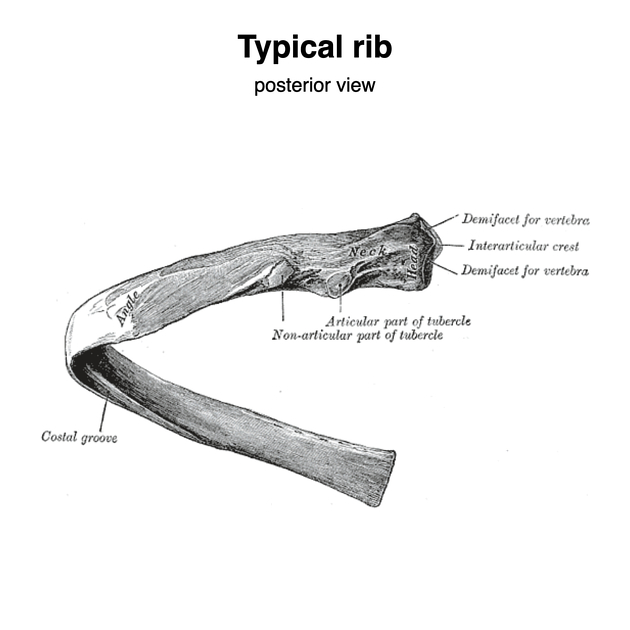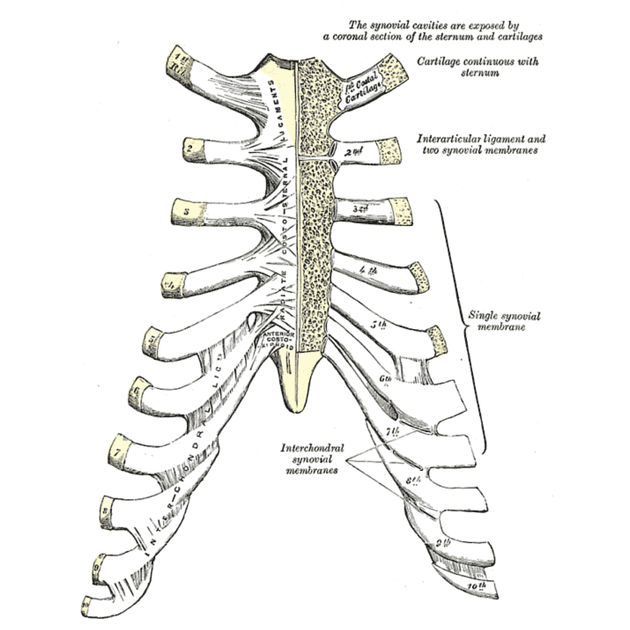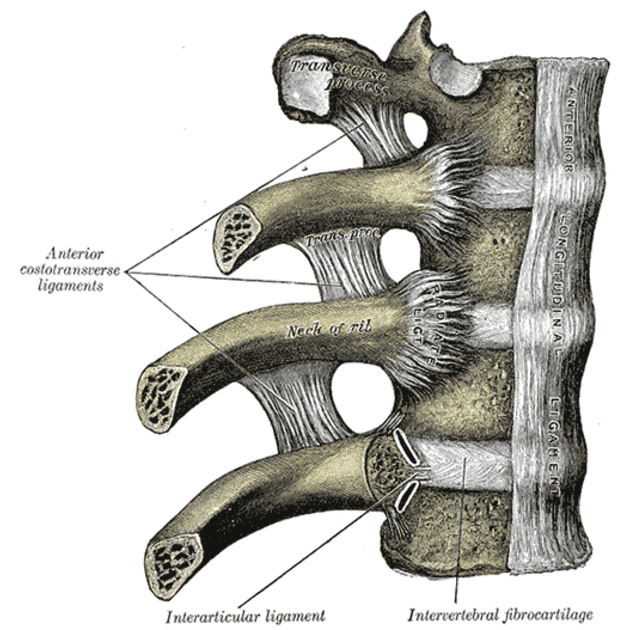The ribs form the main structure of the thoracic cage protecting the thoracic organs, however their main function is to aid respiration 3.
On this page:
Gross anatomy
There are 12 pairs of ribs which are separated by intercostal spaces. The first seven ribs progressively increase in length, the lower five ribs then begin to decrease in length. Ribs are highly vascular and trabecular with a thin outer layer of compact bone.
The 1st, 11th and 12th ribs are considered atypical ribs due to their anatomical features. The remaining ribs are typical.
Ribs can also be divided into true, false and floating ribs:
true ribs: the first seven pairs of ribs are true ribs as they are attached to the sternum directly by costal cartilages anteriorly
false ribs: the 8th to 10th ribs converge anteriorly to each other via costal cartilages and eventually to the seventh rib, therefore, their connection to the sternum is indirect and hence the term false ribs
floating ribs: the 11th and 12th ribs have no anterior direct or indirect sternal attachments and therefore are classified as floating ribs; these ribs are often of variable length
Costal groove
The costal groove runs along the inferior border of each rib. It is situated on the internal aspect of the rib. Each costal groove accommodates an intercostal vein, artery and nerve in that order downwards.
The internal intercostal muscle extends inferoposteriorly from the costal groove to the superior border of the rib below
Costal margin
The costal margin is the lower margin of the thoracic wall.
Anteriorly, cartilage from the 7th, 8th, 9th and 10th ribs form the margin by extending inferolaterally from the xiphisternal joint. The apex of the angle forms the infrasternal or sternal angle. Posteriorly, cartilage from the 11th and 12th ribs form the margin. At its lowest point, cartilage from the 10th rib defines the margin.
The greater part of the liver lies below the right costal margin. In gross hepatomegaly, the liver will extend inferiorly from the right costal margin. The stomach extends below from the left costal margin. The pathologic spleen may extend inferomedially from below the left costal margin.
Attachments
The ribs are attached to corresponding thoracic vertebrae posteriorly. They articulate at the costovertebral joints at the head of the rib and at the costotransverse joints with the tubercle. Anteriorly, most are attached directly to the sternum. They articulate at the costochondral joints with some exceptions.
Musculotendinous
There are a number of muscles related to ribs:
intercostal muscles: situated in the intercostal spaces
diaphragm: arises from the inner surfaces of the costal cartilages on the sixth rib
serratus anterior: originates anterolaterally from the 1st to 8th ribs
pectoralis major and minor muscles arise from superior anterior ribs
latissimus dorsi: originates from the 9th to 12th ribs
scalenus anterior, posterior and medius muscles have attachments on the first and second ribs
rectus abdominis: inserts at the xiphisternum and the 5th to 7th costal cartilages
Variant anatomy
In 35-70% of the population, the 10th rib may also be floating. Additional variation is associated with ethnicity.
Bifid or forked ribs are an uncommon variant occurring in ~0.2% of the population. They may be more prevalent in females and the right side.
Ribs do not always arise from thoracic vertebrae. They may occasionally arise from the seventh cervical (cervical ribs) and first lumbar (lumbar ribs) vertebrae.
Up to 5-8% people have 11 pairs of ribs as a normal anatomic variant 6. Much rarer are supernumerary ribs in normals, although it has been documented 6.












 Unable to process the form. Check for errors and try again.
Unable to process the form. Check for errors and try again.